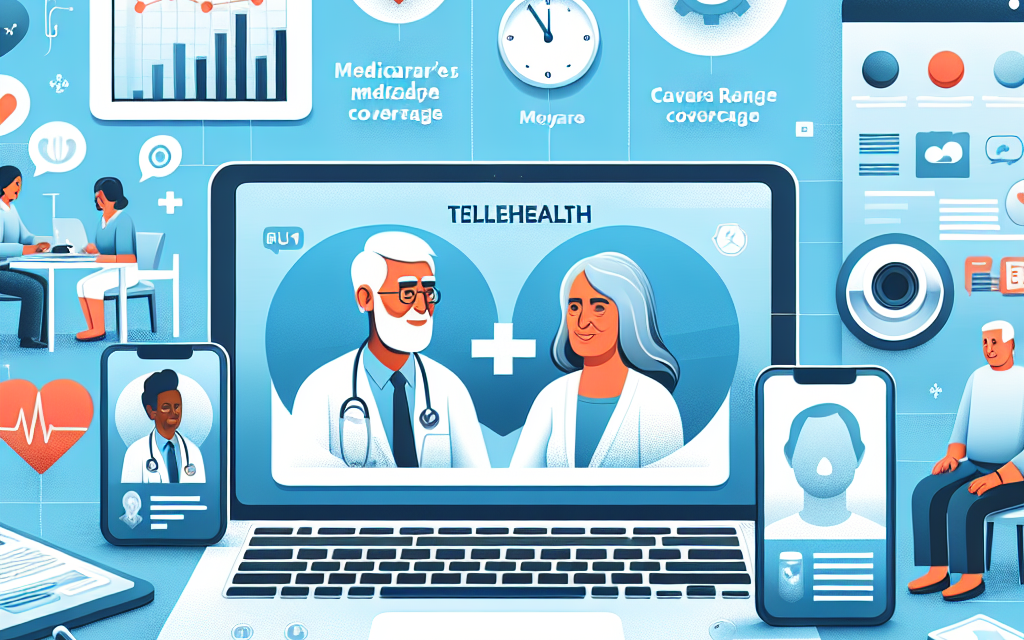Understanding Medicare’s Telehealth Coverage: Key Insights
As the healthcare landscape continues to evolve, telehealth has emerged as a vital component of patient care, particularly for older adults who often face mobility challenges and chronic health issues. Medicare, the federal health insurance program for individuals aged 65 and older, has adapted its coverage policies to include telehealth services, especially in response to the COVID-19 pandemic. This article delves into the intricacies of Medicare’s telehealth coverage, providing key insights into its benefits, limitations, and future directions.
1. The Evolution of Telehealth in Medicare
Telehealth has been around for decades, but its integration into Medicare has seen significant changes, particularly in recent years. Understanding this evolution is crucial for beneficiaries and healthcare providers alike.
Initially, Medicare’s telehealth coverage was quite limited. The program primarily covered telehealth services for patients in rural areas, requiring them to visit a designated originating site, such as a hospital or clinic. This restriction meant that many beneficiaries, especially those in urban settings or with mobility issues, could not access telehealth services.
However, the COVID-19 pandemic acted as a catalyst for change. In March 2020, the Centers for Medicare & Medicaid Services (CMS) expanded telehealth coverage to allow beneficiaries to receive services from their homes. This expansion included a wide range of services, from routine check-ups to mental health counseling, significantly increasing access to care.
- Key Changes During the Pandemic: The temporary waivers allowed for a broader range of services to be covered, including audio-only visits, which were particularly beneficial for those without reliable internet access.
- Increased Provider Participation: Many healthcare providers quickly adapted to telehealth, leading to a surge in virtual visits. According to CMS, telehealth visits increased from approximately 13,000 per week before the pandemic to over 1 million per week by April 2020.
- Legislative Support: The Coronavirus Aid, Relief, and Economic Security (CARES) Act and subsequent legislation provided additional funding and support for telehealth services, further solidifying its role in Medicare.
As the pandemic subsides, discussions continue regarding the permanence of these changes. Policymakers are considering whether to make the expanded telehealth coverage permanent, recognizing its potential to improve access to care for millions of beneficiaries.
2. Types of Telehealth Services Covered by Medicare
Medicare’s telehealth coverage encompasses a variety of services, each designed to meet the diverse needs of beneficiaries. Understanding these services is essential for both patients and providers.
Medicare covers several types of telehealth services, including:
- Virtual Check-Ins: These are brief, remote check-ins with healthcare providers that can be conducted via phone or video. They are typically used for patients who have an established relationship with their provider and need to discuss non-urgent health issues.
- Remote Patient Monitoring: This service allows healthcare providers to monitor patients’ health data remotely, such as blood pressure or glucose levels, using digital tools. This is particularly beneficial for patients with chronic conditions.
- Telehealth Visits: Full telehealth visits can be conducted via video conferencing, allowing for comprehensive evaluations and consultations. These visits can cover a wide range of medical specialties, including primary care, mental health, and specialist consultations.
- Behavioral Health Services: Telehealth has been instrumental in expanding access to mental health services. Medicare covers therapy sessions and psychiatric evaluations conducted via telehealth, addressing the growing mental health crisis among older adults.
- Emergency Services: In certain situations, telehealth can be used for emergency consultations, allowing patients to receive immediate guidance from healthcare professionals without needing to visit an emergency room.
Each of these services plays a crucial role in enhancing patient care. For instance, a study published in the Journal of the American Medical Association found that telehealth visits for mental health services increased by 50% during the pandemic, highlighting the importance of accessible mental health care.
3. Eligibility and Access to Telehealth Services
While Medicare’s telehealth coverage has expanded significantly, understanding eligibility requirements and access points is essential for beneficiaries. Not all services are available to every Medicare beneficiary, and certain conditions must be met.
Eligibility for telehealth services under Medicare typically includes:
- Beneficiary Location: Initially, telehealth services were primarily available to beneficiaries in rural areas. However, during the pandemic, this restriction was lifted, allowing beneficiaries to access services from their homes regardless of location.
- Established Provider Relationship: Many telehealth services require that beneficiaries have an established relationship with their healthcare provider. This means that the provider must have seen the patient in person within a specified timeframe before offering telehealth services.
- Service Type: Not all services are covered under telehealth. Beneficiaries should check with their providers to ensure that the specific service they need is eligible for telehealth coverage.
Accessing telehealth services can also vary based on technology and internet availability. While many beneficiaries have smartphones or computers, others may face challenges due to lack of access or digital literacy. To address these disparities, some organizations have implemented programs to provide training and resources to help older adults navigate telehealth platforms.
For example, the National Council on Aging has developed resources aimed at helping older adults understand and utilize telehealth services effectively. These initiatives are crucial in ensuring that all beneficiaries can take advantage of the expanded telehealth offerings.
4. Challenges and Limitations of Medicare’s Telehealth Coverage
Despite the significant advancements in telehealth coverage under Medicare, several challenges and limitations remain. Understanding these obstacles is essential for beneficiaries and healthcare providers to navigate the telehealth landscape effectively.
Some of the key challenges include:
- Reimbursement Issues: While Medicare has expanded coverage for telehealth services, reimbursement rates may not always match those for in-person visits. This discrepancy can discourage providers from offering telehealth services, particularly in specialties that require more intensive care.
- Technology Barriers: Not all beneficiaries have access to the necessary technology or internet connectivity to participate in telehealth visits. This digital divide can disproportionately affect low-income and rural populations, limiting their access to care.
- Regulatory Hurdles: The regulatory environment surrounding telehealth is complex and varies by state. Providers must navigate different state laws regarding telehealth practice, which can create confusion and limit service availability.
- Quality of Care Concerns: Some healthcare providers express concerns about the quality of care delivered via telehealth compared to in-person visits. While many patients report satisfaction with telehealth services, certain conditions may require hands-on examinations that are not possible through virtual visits.
- Privacy and Security Issues: Telehealth services must comply with strict privacy regulations, including the Health Insurance Portability and Accountability Act (HIPAA). Ensuring the security of patient data during virtual visits is paramount, and breaches can lead to significant legal and financial repercussions.
Addressing these challenges requires collaboration among policymakers, healthcare providers, and technology developers. For instance, initiatives aimed at improving broadband access in rural areas can help bridge the digital divide, while ongoing training for providers can enhance their ability to deliver quality care through telehealth.
5. The Future of Telehealth in Medicare
The future of telehealth in Medicare is a topic of considerable interest and debate. As the healthcare landscape continues to evolve, several trends and potential developments could shape the future of telehealth services.
Some key considerations for the future of telehealth in Medicare include:
- Permanent Expansion of Coverage: Policymakers are actively discussing the possibility of making the expanded telehealth coverage permanent. This would ensure that beneficiaries can continue to access a wide range of services remotely, even after the pandemic subsides.
- Integration of Advanced Technologies: The integration of artificial intelligence (AI) and machine learning into telehealth platforms could enhance patient care by providing more personalized treatment recommendations and improving diagnostic accuracy.
- Focus on Preventive Care: Telehealth has the potential to shift the focus of healthcare from reactive to preventive care. By enabling regular check-ins and monitoring, telehealth can help identify health issues before they become severe, ultimately improving health outcomes.
- Increased Collaboration Among Providers: As telehealth becomes more mainstream, collaboration among healthcare providers will be essential. Integrated care models that leverage telehealth can improve coordination and communication among providers, leading to better patient outcomes.
- Policy and Regulatory Changes: Ongoing advocacy for policy changes will be crucial in shaping the future of telehealth. Stakeholders must work together to address reimbursement issues, regulatory barriers, and technology access to ensure that telehealth remains a viable option for all beneficiaries.
As we look ahead, it is clear that telehealth will play an increasingly important role in Medicare and the broader healthcare system. By addressing current challenges and embracing innovative solutions, stakeholders can ensure that telehealth continues to enhance access to care for millions of older adults.
Conclusion
Medicare’s telehealth coverage has undergone significant transformations in recent years, particularly in response to the COVID-19 pandemic. Understanding the evolution, types of services covered, eligibility requirements, challenges, and future directions of telehealth is essential for beneficiaries and healthcare providers alike.
As telehealth continues to evolve, it holds the potential to improve access to care, enhance patient outcomes, and reshape the healthcare landscape for older adults. By addressing existing challenges and advocating for policy changes, stakeholders can ensure that telehealth remains a vital component of Medicare, ultimately benefiting millions of beneficiaries across the country.
In summary, the key insights into Medicare’s telehealth coverage highlight the importance of ongoing education, advocacy, and collaboration among all stakeholders to maximize the benefits of telehealth for older adults. As we move forward, it is crucial to remain informed and engaged in the discussions surrounding telehealth to ensure that it continues to meet the needs of those it serves.





